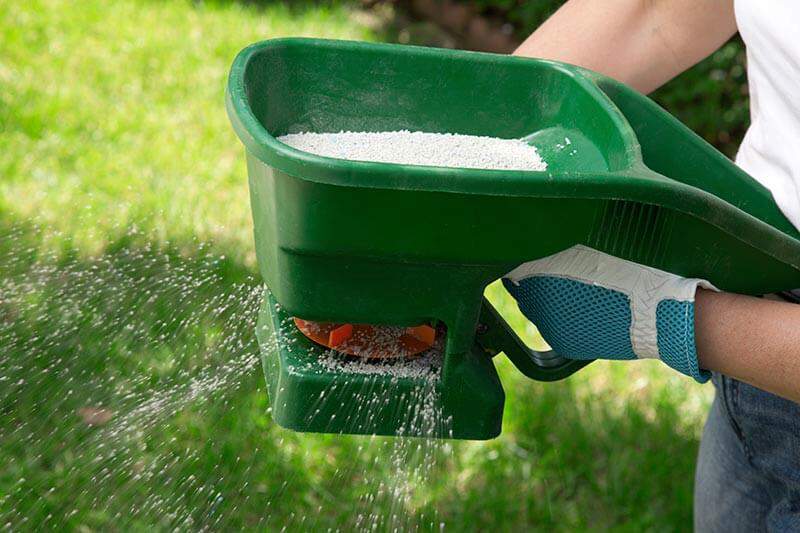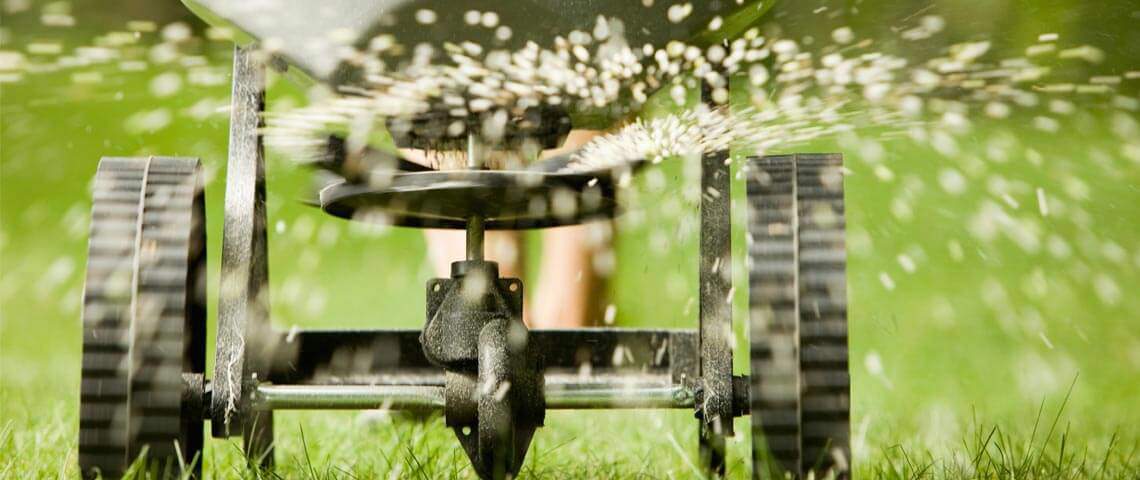How to Choose and Use a Lawn Spreader
Using the right lawn spreader for your turf project can simplify labor and improve end results. But choosing the best spreader for the job is only half the battle — using it properly counts just as much. Whether you're seeding new areas or improving existing lawns, the right spreader helps ensure the most from your efforts and your seed investment. Spreaders don't need to be mystifying. You can choose and use one with confidence, and get your seed down right!
Considerations in Spreader Selection
Spreader designs are fairly simple, but it's important to match the tool to your lawn. Regardless of your project, some basic considerations apply. Before selecting a spreader, let the following help guide your choice:
- Overall size of the area to be seeded
- Shape of the area, such as lines, corners or curves
- Terrain of the seeding area
- Degree of precision needed
- Time concerns or constraints
- Number of obstacles, such as trees and garden beds

Main Types of Spreaders
Spreaders run from small, hand-held tools to heavy-duty, lawn-tractor models. But they come down to two main types: broadcast, also known as rotary, and drop spreaders. Home walk-behind spreaders usually have two wheels — and bigger wheels improve maneuverability. Both broadcast and drop spreaders have bucket-like hoppers with adjustable holes that control the volume of seed that goes through. However, the two types differ in how they distribute seed and what lawn types suit them best.
Broadcast Spreaders
Broadcast spreaders scatter or “broadcast" seed in a fanlike manner over a wide area, with the help of a rotating piece beneath the hopper holes. The size of the fan depends on hole size and your speed. Distribution thins as it gets farther from the spreader, so passes back and forth across the lawn must overlap to uniform seed across the full arc. A general rule is that the “effective width" of the spread is roughly equal to 75 percent of the total reach.2 If your spreader's arc measures 12 feet across to its outermost points, the effective coverage is 9 feet wide. Passes across the lawn should be 9 feet apart.3 For best coverage, set the spreader at 50 percent, and then spread your seed two ways in a crosshatch pattern.
Points to consider with broadcast spreaders include:
- They suit large lawns and cover wide areas efficiently.
- They require more skill to get uniform coverage.
- They lack precision in tight spots and around obstacles.
- They're more affected by wind, especially with lightweight products.
- They can scatter seed or products out of bounds. (Some state laws require cleanup of fertilizer from sidewalks or other hardscapes.1)
- They cover more ground in less time.

Drop Spreaders
Drop spreaders drop seed straight down into neat rows with great accuracy. The gravity-fed seed only goes where you go. The width of your spread equals the distance between the two outermost hopper holes. Because seed drops only between the wheels, you must overlap wheel paths on each pass across the lawn, or you'll miss the paths and get stripes instead. As with the broadcast spreader, you'll get the best coverage — and avoid striping — by setting your spreader at 50 percent, and then spreading your seed two ways in a crosshatch pattern.
Points to remember with drop spreaders include:
- They're well-suited for small lawns (under 5,000 square feet).
- They're simple to use and offer easy coverage control.
- They provide precision in tight spots and around obstacles.
- They're not impacted by normal winds.
- They keep products in bounds, eliminating the need for cleanup.
- They cover less ground per swath, adding to time.
- Whatever spreader you choose, make sure it's in the “off" position before you fill it. Fill over a surface that cleans easily, in case of spills. Open the spreader only once you're in motion and up to speed. Do some header strips first, to give turnaround room, then close the hopper during end turns. Wash your spreader thoroughly after every use.
Spreader Settings
To get the best results, your spreader's hole size must be set so seed comes through at correct rate. The settings may be numbers or letters; the higher the setting, the bigger the hole. Walk-behind spreader settings are based on a walking speed of around 3.5 miles per hour. 1 Consistent speed is essential for uniform coverage.
When you purchase a Pennington grass seed product, the label includes seeding rates and recommended settings for popular spreader models. If your model isn't listed, see your owner's manual for comparisons. For example, recommended seedings rates for Pennington Smart Seed Sun and Shade Grass Seed and Fertilizer Mix are 9 pounds per 1,000 square feet for new lawns and bare spots, and 3 pounds per 1,000 square feet for thin areas or overseeding. The product labels provides spreader settings to match. Always start with your Pennington product's recommendations. Other seed brands often have high amounts of filler and less seed per pound, so they need much higher rates to get similar amounts of actual seed.
Calibrating Your Spreader
It's a good idea to "calibrate" spreaders annually, but do so more often if used frequently. Calibration is determining your spreader's output at any given setting, and then making adjustments to get the rate you desire. If you use your seed spreader for fertilizer and other products, each product requires separate calibration. Calibration also helps accommodate personal nuances, such as comfortable walking speed.
For simple calibration of a walk-behind spreader, follow these easy steps:
- Choose a low to mid-range setting, close to what you think will yield the proper rate.
- Know the effective width of your spreader's coverage per swath.
- Mark off a test-run strip. If you mark off 100 feet and your drop spreader has a 2-foot spread, your test area equals 200 square feet.
- Install a catch pan under your hopper, if available, to collect seed spread during your test.
- Fill your hopper with a known weight of seed, such as 5 or 10 pounds.
- Approach your test area at your intended walking speed. Open the hopper as you cross the start line.
- Keep your pace – but stop dropping seed – as you cross the finish.
- Weigh the seed in your catch pan or the remnant in the hopper, and determine the amount used. If your spreader distributed 1 pound over 200 square feet, that's equal to 5 pounds per 1,000 square feet.
- Adjust your settings and repeat, as needed, to get the application rate you desire.
Using the best spreader for your lawn projects, and using it properly, help prevent product waste and disappointment. Pairing your spreader with premium grass seed, such as Pennington Smart Seed and the full line of Penningtongrass seed products, helps ensure success with your spreader and all your seeding projects.
Pennington and Smart Seed are trademarks of Pennington Seed, Inc.
Always read the product label and follow the instructions carefully.
Sources:
1. Felton, Dr. Gary K., “Maryland Professional Lawn Care Manual," University of Maryland and Maryland Department of Agriculture, January 2013, Ch. 7.
2. Munshaw, Gregg, “Calibrating Fertilizer Spreaders for the Home Lawn," University of Kentucky.
3. Landschoot, Peter, “Calibrating Your Fertilizer Spreader," Penn State College of Agricultural Sciences.

